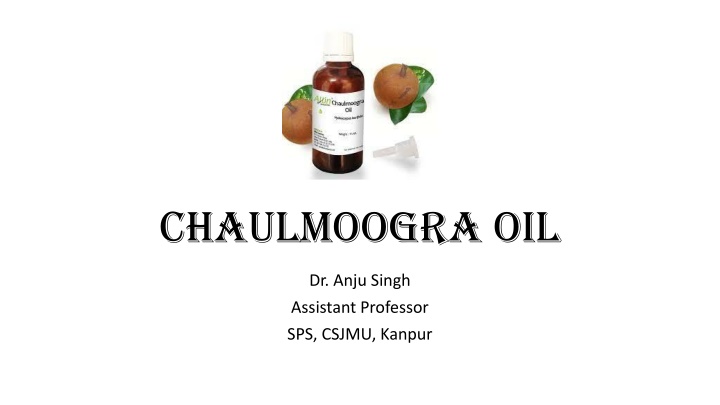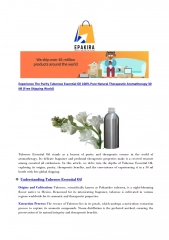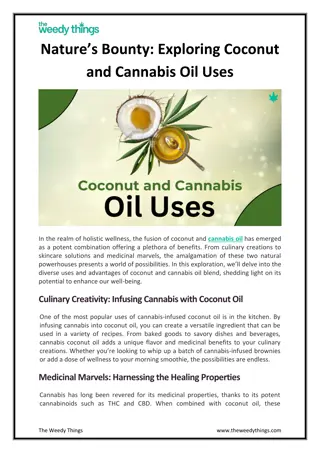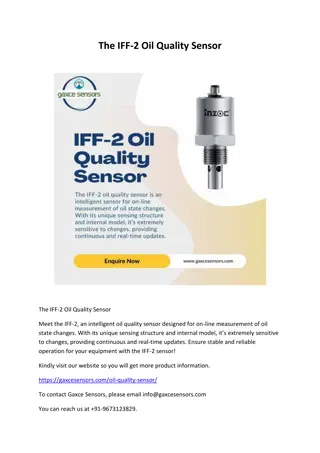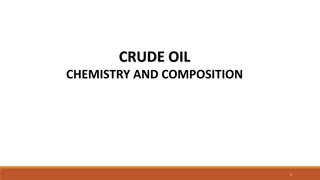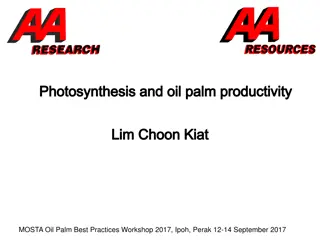Comprehensive Guide to Chaulmoogra Oil: Properties, Sources, and Uses
Chaulmoogra oil, a yellow to brownish-yellow liquid, is extracted from the seeds of the Hydnocarpus plant. This oil contains chaulmoogric acid and hydnocarpic acid, making it valuable in traditional medicine. The oil is prepared by cold expression and has various chemical constituents. It is primarily sourced from Myanmar and is used in skincare and therapeutic applications. Proper storage is essential to prevent adulteration.
Download Presentation

Please find below an Image/Link to download the presentation.
The content on the website is provided AS IS for your information and personal use only. It may not be sold, licensed, or shared on other websites without obtaining consent from the author.If you encounter any issues during the download, it is possible that the publisher has removed the file from their server.
You are allowed to download the files provided on this website for personal or commercial use, subject to the condition that they are used lawfully. All files are the property of their respective owners.
The content on the website is provided AS IS for your information and personal use only. It may not be sold, licensed, or shared on other websites without obtaining consent from the author.
E N D
Presentation Transcript
Chaulmoogra oil Dr. Anju Singh Assistant Professor SPS, CSJMU, Kanpur
Chaulmoogra plant and fruits
description Colour: Yellow to brownish-yellow coloured liquid Odour: Characteristic Taste: Some what acrid Solubility: Slightly soluble in alcohol, soluble in chloroform, ether, benzene and carbon disulphide. It is soft white solid below 25 C.
Source Synonyms: Hydnocarpus oil, Gynocardia oil. Biological Source: Hydnocarpus oil is the fixed oil obtained by cold expression method from ripe seers of the plant Taraktogenos Kurzii King, and Hydnocarpus anthelmintic Pierre, Hydnocarpus heterophylla Kurz and other species of the Hydnocarpus, family Flacourtriaceae, prepared by cold expression method. Geographical Source: Chaulmoogra plant is native of Myanmar, Thailand, and Este India. It is also found in Sri Lanka and Bangladesh. In India, it is grown in Assam and Tripura.
Chemical constitutent It contains chemically esters of unsaturated fatty acids of chaulmoogric acid (27%) and hydnocarpic acid (48%) and glycerides of palmitic acid.
Preparation Seeds are sub-ovoid, obtusely angular and 2 cm in length. Chaulmoogra seeds contain 40 - 45% fixed oil. Seeds are decorticated by machine after grading the kernels are pressed with the hydraulic press and the oil obtained is filtered.
Evaluation/Standard Weight per ml - 0.935 to 0.960 g Acid value not more than 10 Saponification value - 195 to 213 lodine value - 93 to 104 Specific rotation not less than + 48 and not more than +60 Refractive index - 1.472 to 1.476
Storage & adulteration It is stored in closed containers away from light and in cool place. The plant is substituted in India by Hydnocarpus wightiana found abundantly in West Bengal, (Fig. 10.4) Kerala and Western ghats and also by Hydnocarpus alpine occurring in Karnataka, Kerala and Tamil Nadu. During 1995-96, India has exported chaulmoogra oil of Rs. 18 lakhs.
Uses The unsaturated fatty acids of chaulmoogra oil possess strong bactericidal effect, against Mycobacterium leprae, and M. tuberculosis. It is found to be useful in the treatment of T.B., leprosy, psoriasis and rheumatism. It is intended only for external use.
